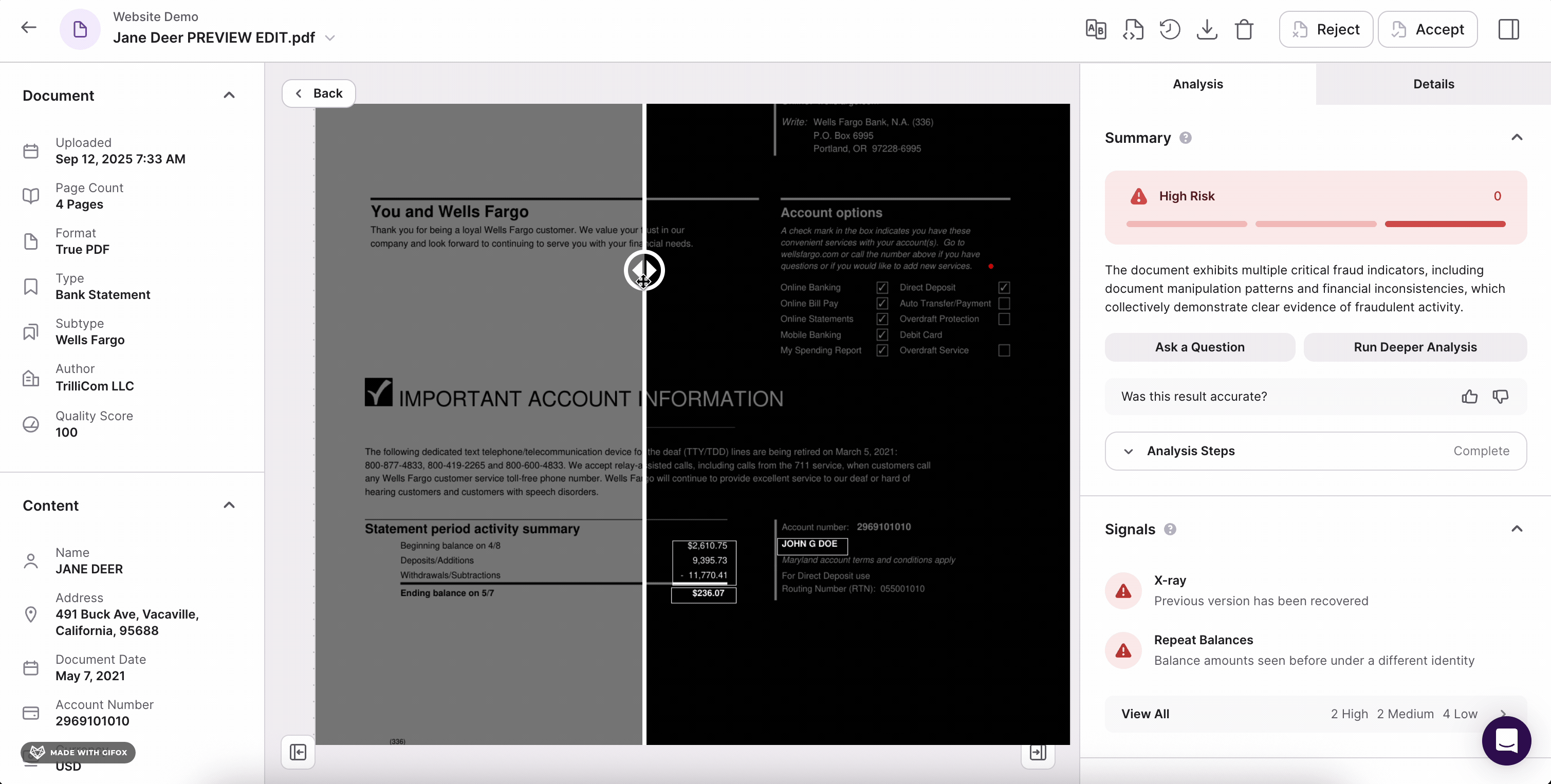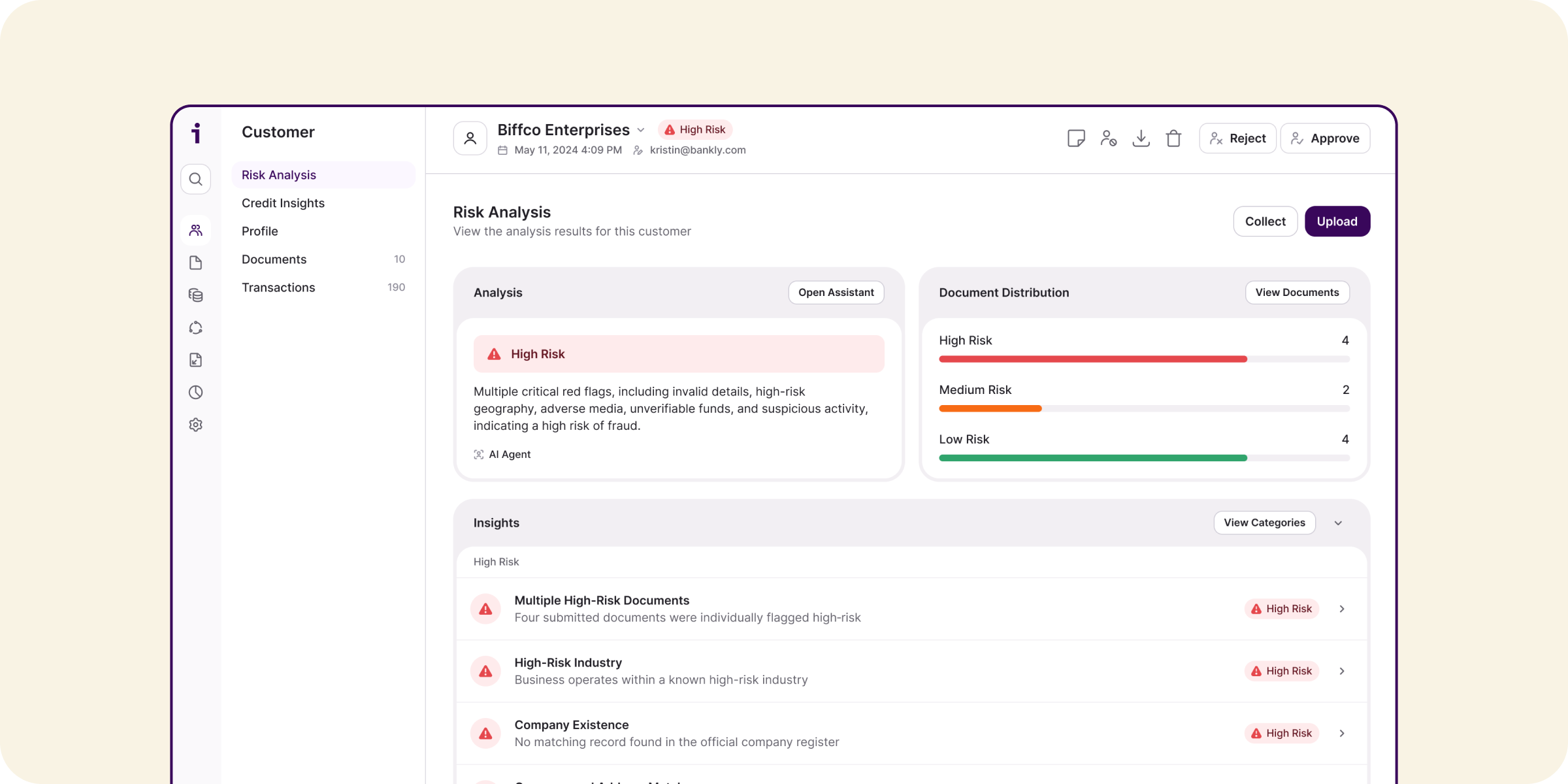Two sides of the truth: Inside and outside the document
Table of Contents
[ show ]- Loading table of contents...
Stephanie Spangler
AI-generated and edited documents are changing the pace of fraud. What once took Photoshop skills can now be done in minutes with GenAI. As a result, risk teams are fighting more fake files than ever, because they’re easier than ever to create.
With Inscribe, you can instantly tell if a document is fraudulent. But our AI Agents go beyond what's in the document and bring together critical context. By combining what’s inside each document with what’s outside it, across multiple files and trusted data sources, Inscribe gives risk teams a holistic view of the applicant and helps you spot inconsistencies that might otherwise go unnoticed.
Inside the document: clues that reveal manipulation
AI-generated and AI-edited documents often look clean and professional, which is the problem. The signs of manipulation hide in the details: subtle inconsistencies, structural anomalies, or logic that doesn’t quite add up.
Inside each file, Inscribe’s AI Agents analyze structure, content, and metadata to uncover these hidden patterns, connecting them across multiple documents to reveal inconsistencies that no single file could show on its own.
Uncover every document’s unique fingerprint
By applying layered detection techniques, Inscribe’s agentic AI exposes fraud hidden to the naked eye, including documents generated or edited with AI. Our detection techniques include:
- Network detection: Fraudsters often reuse the same playbook. Network detection taps into Inscribe’s library of genuine and fraudulent documents to spot recycled templates, suspicious layouts, and repeat patterns. It ensures that fraud that worked before won’t work again.
- Semantic detection: Looks can deceive, but the details rarely lie. Semantic detection cross-checks names, addresses, employment, and income to expose contradictions that don’t add up, helping teams separate trustworthy applications from risky ones.
- Forensic detection: Every document carries a digital fingerprint. Forensic detection analyzes structure, fonts, metadata, and file history to uncover tampering and synthetic files that manual review often misses, giving teams confidence in every approval.
- Perceptual detection: Some fraud hides in the smallest details. Perceptual detection examines documents at the pixel level to reveal edits, AI-generated artifacts, and subtle visual inconsistencies so even the most convincing fakes don’t slip through.
These layered techniques help Inscribe identify manipulation within a document and across them, revealing how a single discrepancy can signal a broader pattern of risk.

Outside the document: context that confirms truth
A single document only tells part of the story. Context reveals whether that story holds up.
That’s why Inscribe’s AI Agents expand their investigation beyond the file, analyzing patterns across multiple documents and validating details through trusted third-party and public data sources. This combination gives risk teams the context they need to understand not just if a document looks real, but whether its story holds up.
Insights based on multiple documents
Fraud rarely happens in isolation. By comparing data, structure, and behavior across related documents, Inscribe’s AI Agents expose coordinated or repeated manipulation that would be invisible in a single file. Cross-document checks include:
- High-risk documents: Identifies when a customer submits multiple high-risk documents, signaling potential fraud patterns at the customer level rather than isolated issues.
- High-severity signals: Flags when serious fraud indicators appear across several documents in the same application, helping teams prioritize their reviews.
- Previous fraudulent applications: Detects whether an applicant has submitted documents linked to earlier confirmed fraud cases, revealing repeat behavior that points to organized activity.
- Salary cross-check: Extracts salary data from bank statements and compares it to pay stubs to verify distributions, pay periods, bonuses, and rates. This ensures that claimed income matches real transaction flows.
These insights help connect the dots between applications, revealing when small inconsistencies add up to something bigger.
Insights based on external sources
Context matters most when it’s grounded in the real world. To confirm that document data reflects reality, Inscribe’s AI Agents cross-reference details against public and third-party sources. This ensures that every applicant, company, and address can be verified and trusted. These checks include:
- Address verification: Confirms whether a provided address actually exists, helping to detect fraudulent applications using fake or fabricated locations.
- Person and employer connections: Validates that the applicant is genuinely linked to their claimed address and that their stated employment relationship is legitimate.
- Business verification: Checks whether a company exists, is registered, and is active. Company details are validated through Secretary of State data, corporate filings, and trusted online records.
- Ownership confirmation: Uses public data or company websites to verify that the listed owner or principal is genuinely tied to the business.
- Web presence: Searches for a credible online footprint—such as a website, industry directory, or business listing—to confirm that the company is trading and operational.
- Adverse media screening: Surfaces negative or high-risk media coverage related to the business or beneficial owner, giving teams early insight into potential reputational or compliance risks.
- Source of funds and transaction alignment: Cross-checks the applicant’s stated source of funds against bank activity and web data to confirm that account behavior matches the claimed nature of the business.
- High-risk geography and industry: Flags entities operating in higher-risk countries or sectors, helping compliance teams focus on cases with elevated exposure.

Together, these external checks connect document details to verified reality, ensuring that what’s written aligns with what’s true.
How these insights roll up
Based on the analysis of what’s inside and outside the document, each customer receives a risk rating of Low, Medium, or High, along with a short, plain-language explanation of why that rating was assigned.
You can configure which insights carry the most weight and how they roll up into your overall Inscribe risk rating.
This flexibility lets your team tailor Inscribe’s analysis to your priorities, whether that’s verifying income for lending, confirming ownership for onboarding, or identifying high-risk industries for compliance.
Why it matters
Together, these insights, across documents and from external data, give risk teams clarity across key use cases such as:
- Loan origination, where verifying employment, income, and business legitimacy reduces default and fraud losses.
- Business account onboarding, where entity and ownership verification prevent shell companies or synthetic identities from slipping through.
- KYB and compliance checks, where public data confirms beneficial ownership, adverse media, and risk exposure.
The complete picture
As AI makes document fraud faster and more sophisticated, the edge comes from understanding context, not just within a single file, but across every data point connected to it.
By combining clues inside the document with context outside it, across multiple documents and verified third-party data, Inscribe’s AI Agents deliver a complete, holistic view of the applicant.
See how Inscribe’s AI Agents uncover truth inside and outside the document by starting your free Inscribe trial.
About the author
Stephanie Spangler is the Head of Product Marketing at Inscribe, where she leads efforts to promote AI-driven solutions for banks, fintechs, and lenders. Stephanie is a seasoned product marketing leader with over 15 years of experience in driving go-to-market strategies for B2B software companies. As a three-time founding Product Marketer, she has successfully launched and scaled products in competitive markets. With experience as a product marketing consultant and previous leadership roles at Sendoso and Sage, Stephanie is known for her expertise in market analysis, customer insights, and strategic product positioning.
What will our AI Agents find in your documents?
Start your free trial to catch more fraud, faster.






